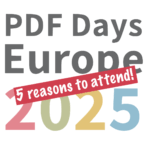PDF/X and the other PDF standards

Dietrich von Seggern received his degree as a printing engineer, and in 1991 started his professional career as head of desktop prepress production in a reproduction house. He became involved in research projects for digital transmission of print files, and moved to the German Newspaper Marketing Organisation (ZMG). There Dietrich was … Read more


by Dietrich von Seggern
Specialized ISO standards based on the Portable Document Format are available for a wide range of purposes.
Originally developed by Adobe Systems in 1993, PDF 1.7 became an open standard in 2008 as ISO 32000-1. PDF 2.0 will be published in 2017.
PDF/A (ISO 19005)
PDF/A is designed to provide a robust digital file format replacing traditional paper or digital TIFF archives. Design goals of PDF/A include consistency, completeness and an unambiguous internal structure. The archival specification for PDF is not only used in archives, but also in cases where the reliability of digital documents is crucial, e.g. in the exchange of construction data between companies.
The standard’s first part, PDF/A-1, was published in 2005. The technical concepts at work in this specification are based on experience with PDF/X (fonts must be embedded, colors must be defined in a device independent way, etc.). In turn, some of the more detailed provisions of PDF/A (e.g., font encoding and metadata) were adopted by PDF/X-4 in 2010. PDF/A defines two conformance levels; PDF/A-1b is the “basic” version while additional requirements pertaining to searchability and accessibility, are covered in PDF/A-1a.
PDF/A-2, published in 2011, differs from PDF/A-1 in that it is based on ISO 32000-1 (see above). This change makes conversion to PDF 1.4 (as required by PDF/A-1) unnecessary, so users leveraging features of PDF 1.7 need not lose those features when making PDF/A files.
PDF/A-3 (published in 2012) is identical to PDF/A-2 but allows for embedding arbitrary file formats. It’s intended for controlled processes, and to provide additional information to the PDF/A file such as formulas in a spreadsheet or machine readable data in a XML file.
PDF/E (ISO 24517)
Based on Adobe’s PDF 1.6, this standard has been available since 2008. It is aimed at engineering documents such as construction drawings and is usually derived from CAD files. PDF/E can display rotating and folding 3D objects on-screen, using tools like Adobe Reader. An update to PDF/E based on PDF 2.0 is currently under development.
PDF/VT (ISO 16612-2)
PDF/VT, published in 2010, supports variable data printing as is often used for invoices or personalized advertisements. “VT” stands for “variable data and transactional printing”. PDF/VT requires conformance with PDF/X-4.
PDF/UA (ISO 14289)
The “UA” in PDF/UA, originally published in 2012, stands for “Universal Access”. This specification includes provisions for making PDF files accessible to users with disabilities who must use assistive technology (AT) to read. In this context, so-called “Tagged PDF” provides the necessary structur.al information to enable navigational aids, reading software or Braille displays to navigate and present page content (text, images, diagrams, etc.).
Correct structure information also enables reuse of PDF content, for example to reflow a document’s text on a mobile device to improve the reading experience.
Overview
| PDF Standard | Introduced | Purpose | Segment |
| PDF/X | since 2001 | “Prepress digital data exchange using PDF” | Printing industry |
| PDF/A | since 2005 | “PDF Archive” | Long-term archiving |
| PDF/E | since 2008 | “PDF Engineering” | Construction diagrams with accurate measurements and live 3D models |
| since 2008 | “Portable Document Format” | Corresponds with Adobe’s PDF version 1.7 | |
| PDF/VT | since 2010 | “PDF for Variable Data and Transactional Printing” | Variable data printing |
| PDF/UA | since 2012 | “PDF for Universal Access” | Universally accessible PDF documents |




